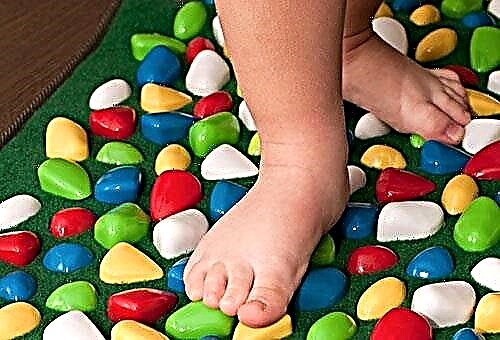Every child had feces with blood at least once. This often did not indicate a serious illness. Most often, a similar symptom is accompanied by minor rectal bleeding, which provokes constipation. Only a doctor can find out what actually caused the appearance of blood by examining the child. There are also dangerous pathologies that provoke bleeding in the digestive organs, the treatment of which cannot be postponed.

Baby
Normal stool in a child
Normally, the baby's feces before the introduction of complementary foods are mushy, light brown, may be yellowish or orange. Sometimes lumps of white color are observed, resembling cottage cheese. Its smell is not disgusting, it is similar to sour milk. In breastfed babies, it is more liquid, "artificial" go to the toilet regularly. Their stools are denser, viscous and odorless.
It happens that foam appears in the stool of the child, a little mucus, they become greenish. If this happens once and does not repeat itself, there is no cause for concern. This is usually a reaction to the foods the mother has eaten, or a signal that the formula is not suitable for the baby. Also, mucus, for example, can be observed during teething in an infant, especially if during this period the child has transparent and abundant snot.
The crumbs of the first month of life poop after almost every feeding; as they grow older, the frequency of bowel movements decreases. Usually, a child on gw goes to the toilet 2-3 times a day, the absence of a chair is allowed up to 10 days. At the same time, the baby should remain calm, eat well and sleep, if you feel his belly, it will be soft and painless.
Note! Crumbs that eat mixtures poop regularly. If there is no stool for more than two days, it is worth taking action. Bottle-fed babies often suffer from constipation.
After getting acquainted with adult food, the baby's stool becomes more shaped and darker. The smell changes, it depends on the food used by the crumb. If the baby continues to drink breast milk, the feces may still resemble gruel, the main thing is that it remains on the surface of the diaper and is not absorbed into it, otherwise the baby will be diagnosed with diarrhea.
Why does the baby poop with blood
Drops and blood clots seen in a diaper are always a concern for parents. Usually, in children, such a symptom does not indicate the presence of a serious illness, but this is not a reason to postpone the visit to the doctor. Only with a personal examination can you find out what caused the appearance of blood, and what treatment the baby needs.

Baby at the doctor
The meaning of color and consistency
Any deviation from the norm, which is of a protracted nature, should alert parents:
- Black stools appear with bleeding in the upper gastrointestinal tract. This color often causes excess iron in a child's diet. It can be found in baby medications or formula. Products of a dark green color are stained in black activated carbon;
- Blood streaks are bright red - a sign of bleeding in the lower gastrointestinal tract. But don't panic right away. Perhaps the baby was pushing hard, and he had a minor anal fissure. This is especially true if the crumbs are periodically constipated. You will also have to remember what the child ate in the next day. Beets, tomatoes, currants, any dyes of a similar shade contained in food can color the chair. Foods may not be completely digested by the baby and come out in the stool. This is how blotches of red appear.
It is impossible to immediately determine why the child poops with blood, and whether it is dangerous for the baby's health. You need to show the baby to the doctor. Often, examining the patient and talking with his mother is enough to find out the cause. If necessary, additional tests and studies are prescribed.
Latent blood in the stool
Not always, if a child has bleeding in one of the parts of the gastrointestinal tract, this can be seen in his stool. Even red blood cells are not recorded in any way when examining stool. To exclude pathology, an occult blood test is prescribed. Usually this item is included in a general study of feces or a coprogram. If the result is positive, then we can talk about a violation of the mucous membrane of the stomach or intestines. In this case, a small amount of blood is released, which cannot be discerned with the naked eye. Timely diagnosis helps prevent a number of dangerous diseases.
Anal fissure
If the baby is constipated, an anal fissure may appear. Then traces of fresh blood will be noticeable in the stool. The child experiences pain when he tries to go to the toilet, he screams, groans, cries.

The baby is crying
Note! If the baby has a tendency to stool retention, action should be taken immediately. When the baby poops in small hard balls, while pushing and reddening, he starts constipation.
Juvenile polyps
On the mucous membrane of the large intestine, growths sometimes form. In children under two years of age, they are rarely diagnosed. Polyps do not cause pain and discomfort, but they can provoke the appearance of fresh blood. In this case, you need to discuss with your doctor, monitor them or remove.
Bowel obstruction
Children sometimes have intestinal obstruction. In infants, it is usually congenital. In newborns, this can happen due to meconium - the original feces are quite viscous and can clog the intestinal lumen.
With intestinal obstruction, in addition to blood in the stool, there are:
- Sharp pain that comes on suddenly;
- Abdominal distension that occurs asymmetrically
- Retention of gas and stool.
This condition requires an ambulance call.
Mucus for constipation
Mucus with delayed bowel movements is more common in adults. In children, its appearance is usually associated with infections with worms. At the same time, the child is nauseous, he is worried about severe abdominal pain. A similar symptom can appear with intestinal obstruction. It is important to establish what exactly caused the appearance of mucus, for this it is necessary for the child to be examined by a doctor.
Other causes of the presence of blood
In babies under one year old, blood in the stool appears with an allergy to cow's milk protein. It may be accompanied by diarrhea, vomiting. Usually, this reaction disappears by the age of one year, children outgrow and begin to consume dairy products without consequences.
To check if the baby has allergies, mom will have to reconsider her diet for a couple of weeks. All products containing milk must be removed from it. The exception is usually hard cheese, sometimes cottage cheese is allowed, but only after storage in the freezer. If the unpleasant symptoms disappear, then the assumption is correct. A mother who wants to save her guards should not eat foods that provoke a negative reaction for up to a year.

Natural feeding
For children, "artificial" select other mixtures, which are based on goat milk or split cow.
Note! It is important to replace the product gradually, otherwise the digestive system of the crumbs will react with the appearance of new symptoms.
An intestinal infection can cause blood in the stool of the crumbs. Dirty hands are usually the main cause of the disease. The baby's temperature rises, the stool is upset, and vomiting begins. It is important to prevent dehydration of the crumbs. Children under one year old are recommended to be observed in a hospital setting.
Diagnostic measures
When blood is found in a child's stool, you need to see a doctor. It is often enough just to examine the baby. The doctor conducts a rectal examination with a finger. He should put on a sterile glove and use ointment so as not to damage the mucous crumbs. To exclude inflammation and assess the functioning of the digestive organs, a coprogram is prescribed, it allows not only to see the latent blood, but also to learn about the work of enzymes, the degree of absorption of food, whether it is completely absorbed.
When help is needed
When parents notice blood in the child's feces, an urgent need to visit a doctor in the following cases:
- The kid suffers from pain, screams, twists his legs;
- The crumbs have lost their appetite, he is lethargic and apathetic;
- The body temperature rises;
- The baby has a rash on the body or another sign of an allergic reaction;
- There is a sharp decrease in weight;
- The child is sick, vomiting begins.
The smaller the patient, the faster you need to act. You can not refuse a visit to the doctor without the occurrence of accompanying symptoms. During the examination, you need to remember what the child ate, perhaps his mood changed. The details will help the doctor diagnose.
Preventive measures
To reduce the risk of bloody stools in a child, you need to monitor his diet. It is important to avoid constipation. To do this, the baby's diet should contain vegetables, fruits, fermented milk products, the baby should be watered abundantly. Do not forget that "artificial" need to be given water at any age.

Kid drinks water
Note! Do not violate the recommendations for preparing the mixture indicated on the pack. The powder must be mixed thoroughly so that no lumps remain in the food.
Massage and gymnastics help to improve digestion. Simple exercises mom and dad can do at home. It is enough, an hour after eating, to stroke the belly of the crumbs in a circle, lightly pressing with the pads of your fingers. Before meals, the baby is laid out on the stomach.
Bearing in mind that worms can provoke the appearance of blood in the feces, you need to wash your hands thoroughly before communicating with the baby. As early as possible to accustom him to a good habit. A one-year-old kid is already getting to know the world around him with might and main, digging in the sandpit, playing on the playground. Therefore, personal hygiene is essential. If there are animals in the house, then you need to protect the child from close contact with them, especially if they spend a lot of time on the street.
Resume for parents
Usually, if parents see a poop with blood in a child, they panic. Its appearance in the stool does not always indicate the presence of a serious illness. The well-known children's doctor Komarovsky emphasizes that moms and dads in any case must maintain their composure. The baby always needs sensible parents. First of all, you need to evaluate the baby's diet and his behavior in recent days, remember when he went to the toilet the previous time, whether it was hard for him to poop, or his behavior did not differ from usual.

The baby is doing well
To establish the cause of bloody stools, you need to visit a doctor. This should be done as soon as possible if additional symptoms appear, in particular, acute pain, fever. Even if there were no other signs of illness, it doesn't hurt to consult a doctor. It is always easier to prevent a disease than to treat it. In addition, if a pathology is indeed found in the baby, it is easier to cope with it at the initial stage.
Note! If the child has microscopic cracks in the anus, then one visit to the doctor will be enough. They are visible during routine inspection. The doctor will immediately make appointments.
When a stool with an admixture of blood appears in a baby, you need to visit a doctor. At the same time, there is no need to worry, suspecting terrible diagnoses. The most common reasons for this in children of the first year of life are minor cracks in the anus and an allergy to cow protein. If you take action in time, then the stool will return to normal. Proper nutrition, massage will help avoid constipation, which means that they will exclude the main cause of the appearance of anal fissures.



